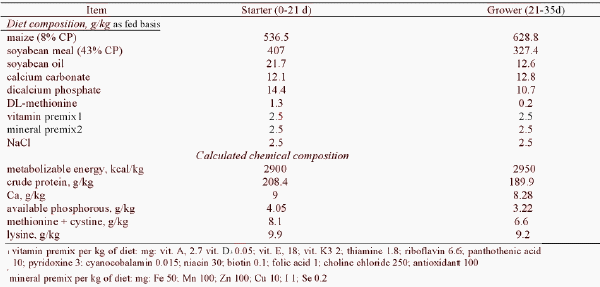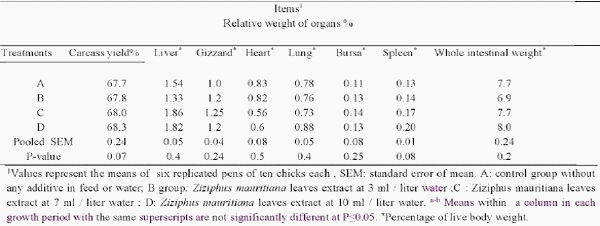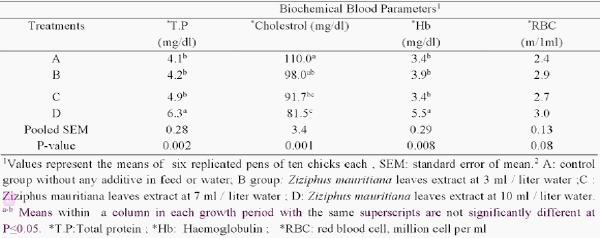Efficacy of Ziziphus mauritiana leaves extract as antibiotic alternatives in broiler chicken
The current experiment was conducted to evaluate the efficacy of oral administration of hydroalcholic Ziziphus mauritiana leaves extract (AZL) as antibiotic alternatives on growth performances, internal organs, lymphoid organs (spleen, Bursa) and blood biochemical characters of broiler during the period from 20 November to 26 December 2016 at the farm of Al Qasim Green University, Babylon, Iraq. A total of 160 one- day old male Ross broilers were divided randomly into 4 treatments with 4 replicate (10 birds per pen). The AZL was added at 0, 3, 7, and 10 ml / liter to water during starter (1-21 day) and grower (22-35) periods. The results showed that AZL increased the body weight and body weight gain at the all AZL groups but with no significant differences. During the grower period, the feed consumption was significantly higher (P<0.05) in the AZL group of 10 ml/litter (1910 gm) as compared with control (1700 gm). The feed conversion ratio (FCR) was significantly lower (P<0.04) at the 3ml/litter (1.38) as compared with control (1.59). Regarding, the internal organs, AZL showed no significant effects on lung, heart, gizzard, spleen, Bursa, and intestinal weight at the end of experimental period. On day35, Hemoglobin (Hb) and Total protein (TP) were found significantly higher (P<0.002) in AZL group of 10 ml /liter than control. The blood cholesterol level was significantly declined (P<0.001) for all AZL groups. It can be concluded that AZL shows a good results especially in low dose in growth performance, blood biochemical characters.
Keywords: antibiotic, broiler, blood, organ, performance, Ziziphus




1. Lu YYP, Zhao ZC, Wang SYC, Fu CX. Composition and antimicrobial activity of the essential oil of Actinidia macrosperma from China. Natural Product Research. 2007; 21(3):227-233.
2. Mbwambo ZH, Moshi MJ, Masimba PJ, Kapingu MC, Nondo RSO. Antimicrobial activity and brine shrimp toxicity of extracts of Terminalia brownii roots and stem. BMC Complementary and Alternative Medicine. 2007; 7(1):1-9.
3. Santos PRV, Oliveira ACX, Tomassini TCB. Control microbiogicode productos. Fitoterapicos. Revista Brasileira de Ciências Farmacêuticas. 1995; 31:35-38.
4. Ellof JN. Which extractant should be used for the screening and isolation of antimicrobial components from plants? Journal of Ethnopharmacology. 1998; 60(1):1-6.
5. Mothana RAA, Gruenert R, Bernarski PJ, Lindequist U. Evaluation of the in vitro anticancer, antimicrobial and antioxidant activities of some Yemeni plants used in folk medicine. Pharmazie. 2009; 64(4):260-268.
6. Adzu B, Amos S, Amizan MB, Gamaniel K. Evaluation of the antidiarrhoeal effects of Ziziphus spina-christi stem bark in rats. Acta Tropica. 2003; 87(2):245-250.
7. Okoko T, Oruambo IF. The effects of Hibiscus sabdariffa calyx on cisplatin-induced tissues damaged in rats. Biokemistri. 2008; 20(2):47-52.
8. Abalaka ME, Daniyan SY, Mann A. Evaluation of the antimicrobial activities of two Ziziphus species (Ziziphus mauritiana L. and Ziziphus spinachristi L.) on some microbial pathogens. African Journal of Pharma and Pharmacology. 2010; 4(4):135-139.
9. Hassan SM, Sultana B, Iqbal M, Naz S. Biological approach to aflatoxin control in stored poultry feed. Acta Veterinaria Brno. 2017; 86(1):19-28.
10. NRC. National Research Council. Nutrient requirements of Poultry. 9th revised. ed. National Academy Science, Washington. DC. 1994.
11. Kelley WR. Veterinary Clinical Diagnosis. 3rd ed. Bailiere Tindall. London. 1984, 312.
12. Nagappan R. Evaluation of aqueous and ethanol extract of bioactive medicinal plant, Cassia didymobotrya (Fresenius) Irwin & Barneby against immature stages of filarial vector, Culex quinquefasciatus Say (Diptera: Culicidae). Asian Pacific Journal of Tropical Biomedicine. 2012; 2(9):707-711.
13. IBM Corp. IBM SPSS Statistics for Windows, Armonk, NY: IBM Corp. Released 2010. Version 19.0.
14. Hernandez F, Madrid J, Garcia V, Orengo J, Megias MD. Influence of two plant extracts on broilers performance, digestibility, and digestive organ size. Poultry Science. 2004; 83(2):169-174
15. Toghyani M, Tohidi M, Gheisari AA, Tabeidian SA. Performance, immunity, serum biochemical and hematological parameters in broiler chicks fed dietary thyme as alternative for an antibiotic growth promoter. African Journal of Biotechnology. 2010; 9(40):6819-
6825.
16. Demir E, Sarica S, Ozcan MA, Suicmez M. The use of natural feed additives as alternatives for an antibiotic growth promoter in broiler diets. British Journal of Poultry Science. 2003; 44(1, Supplement):544-545.
17. Awaad MHH, Elmenawey M, Ahmed KA. Effect of aseptic combination of carvacrol, cinnamaldehyde and capsicumo Leorsin on the growth performance, carcass quality and gut integrity of broiler chicken. Veterinary World. 2014; 7(3):284-290.
18. Botsoglou NA, Christaki E, Florou-Paneri P, Giannenas I, Papageorgiou G, Spais AB. The effect of a mixture of herbal essential oils or α-tocopheryl acetate on performance parameters and oxidation of body lipid in broilers. South African Journal of Animal Science. 2004; 34(1):52-61.
19. Lee KW, Everts H, Kappert HJ, Yeom KH, Beynen AC. Dietary carvacrol lowers body weight gain but improves feed conversion in female broiler chickens. Journal of Applied Poultry Research. 2003; 12(4):394-399.
20. Bhardwaji M, Singh BR, Sinha DK, Kumar V, Prasanna Vadhana OR, Varan Singh S et al. Potential of herbal drug and antibiotic combination therapy :Areview approche to treat multidrug resistant bacteria. Pharm. Anal. Acta, 2016; 7(11).
21. Sharifi SD, Khorsandi SH, Khadem AA, Salehi A, Moslehi H. The effect of four medicinal plants on the performance, blood biochemical traits and ileal microflora of broiler chicks. Veterinarski arhiv. 2013; 83(1):69-80.
22. Naseri G, Rahimi KS, Khaki P. Comparison of the Effects of Probiotic, Organic Acid and Medicinal Plant on Campylobacter jejuni challenged broiler chickens. Journal of Agricultural Science and Technology. 2012; 14:1485-1496.
23. Rahman M, Jin Kim S. Effects of dietary Nigella sativa seed supplementation on broiler productive performance, oxidative status and qualitative characteristics of thighs meat. Italian Journal of Animal Science. 2016; 2(143):87-176.
24. Motamedi H, Seyyednejad SM, Hasannejad Z, Dehghani F. Comparative Study on the effects of Ziziphus Spina-christi alcoholic extracts on growth and structural integrity of bacterial pathogens. Iranian Journal of Pharmaceutical Science. 2014; 10(2):1-10.
25. Son JH. Effects of Dietary Zizyphus jujuba Seed Meal on Broiler Performance. Korean Journal of Poultry Science. 2014; 41(4):279-285
26. Dahiru D, Obidoa O. Effect of aqueous extract of Ziziphus maritiana leaf on cholesterol and triglyceride levels in serum and liver of rats administrated alcohol. Pakistan Journal of Nutrition. 2009; 8(12):1884-1888.
27. Ganachari MS, Kumar S. Effect of Ziziphus jujuba leaf extract on body weight, food intake and serum lipid levels in sucrose-induced obese rats. Indian Journal of Pharmaceutical Science. 2004; 66(3):363.
28. Ashour SE. Heatological and biochemical studies on the effect of some natural antioxidants pre- injection in irradiation rat. Ph.D. Thesis. Faculty of Agriculture, Benha University, 2011.
29. Cai LW, Ramanatha S. Potential anti radical activity and cyto toxicity assessment of Ziziphus maritiana and Syzygium polyanthum. International Journal of Pharmacology. 2012; 8(10):535-541.
30. Togun VA, Oseni BSA. Effect of low level inclusion of
biscuit dust in broiler finisher diet on pre-puberal growth and some haematological parameters of unsexed broilers. Research Journal of Animal Science. 2003; 1(2):10-14.
31. Olorode BR, Adeniran RA, Abiola JO. Effect of graded levels of Moringa oleifera seed meal on haematological values and organ weight of broiler chicken. Tropical Journal of Animal Science. 2007; 10:63-67.
32. Etim NN GE. Enyenihi GE, Akpabio U, Offiong EEA. Effects of nutrition on hematology of rabbits: a review. European Scientific Journal. 2014; 10(3):413-424.
33. Otto F, Baggasse P, Bogin E, Harun M, Vilela F. Biochemical blood profile of Angoni cattle in Mozambique. Israel Veterinary and Medicine Association. 2000; 55(3):1-9.
34. Opara MN. The grasscutter: haematology and major parasites. Research Journal Parasitology. 2010; 5(4):214-223.
35. Ogbuewu IP, Kadurumba OE, Okoli IC Iloeje MU. Effect of ginger rhizome powder supplement and sex on haematological indices of pre-pubertal rabbits. Journal of Agricultural Technology. 2013; 9(1):11-19
36. Kaneko JJ, Harvey JW, Bruss ML. Clinical Biochemistry of Domestic Animals. Academic Press, San Diego, CA, USA, 1997.
37. Akinfola EO, Matanmi O, Fatufe AA. Effect of residual cyanogenic glycosides in cassava based diets on serum metabolites of cockerel chicks. Proceedings of the 32nd Annual conference of the Nigerian Society for Animal Production (NSAP), March 18–21. University of Calabar, Nigeria, 2007, 105-107.
38. Oforjindu O. The toxicity of graded levels of graded levels of Neem (Azadirachta indica) leaf meal. Agricultural Technology Project Report, Federal University of Technology, Owerri, 2006, 1-34.
39. Obikaonu HO, Okoli IC, Opara MN, Okoro VMO, Ogbuewu IP, Etuk EB et al. Haematological and serum biochemical indices of starter broilers fed neem (Azadirachta indica) leaf meal. Online Journal of Animal and Feed Research. 2011; 1(4):150-155.
40. Dahiru D, Obidoa O. Evaluation of the antioxidant effects of Ziziphus mauritiana lam. leaf extracts against chronic ethanol-induced hepatotoxicity in rat liver. African Journal of Traditional Complements and Alternative Medicines. 2008; 5(1):39-45.
41. Bukar AM, Kyari MZ, Gwaski PA, Gudusu M, Kuburi FS, Abadam YI. Evaluation of phytochemical and potential antibacterial activity of Ziziphus spina-christi L. against some medically important pathogenic bacteria obtained from University of Maiduguri Teaching Hospital, Maiduguri, Borno State – Nigeria. Journal of Pharmacognosy and Phytochemistry. 2015; 3(5):98-101.
42. Goyal M, Nagori B, Sasmal D. Review on ethnomedicinal uses, pharmacological activity and phytochemical consistuents of Ziziphus maritiana. Spatula DD. 2012; 2(2):107-116.
43. McRae MP. Vitamin C supplementation lowers serum low-density lipoprotein cholesterol and triglycerides: a meta-analysis of 13 randomized controlled trials. Journal of Chiropractic Medicine. 2008; 7(2):48-58.
Very nice finding. Thank you for sharing. I need to know the active ingredients of the plant that kill/reduce growth of bacteria?
Very nice information which is the need of hour as the side effects of antibiotics is complicated and kills the immune power both for bird and the end user. Similarly, there are aromatic oils, spices, garlic, etc., which are to be studied for the antibiotic properties and awareness is to be created to people with practical studies.










.jpg&w=3840&q=75)